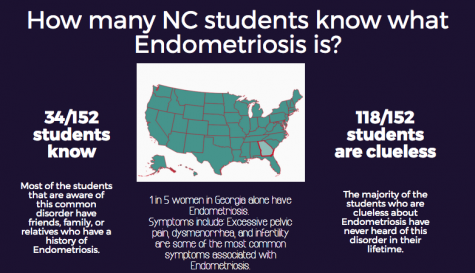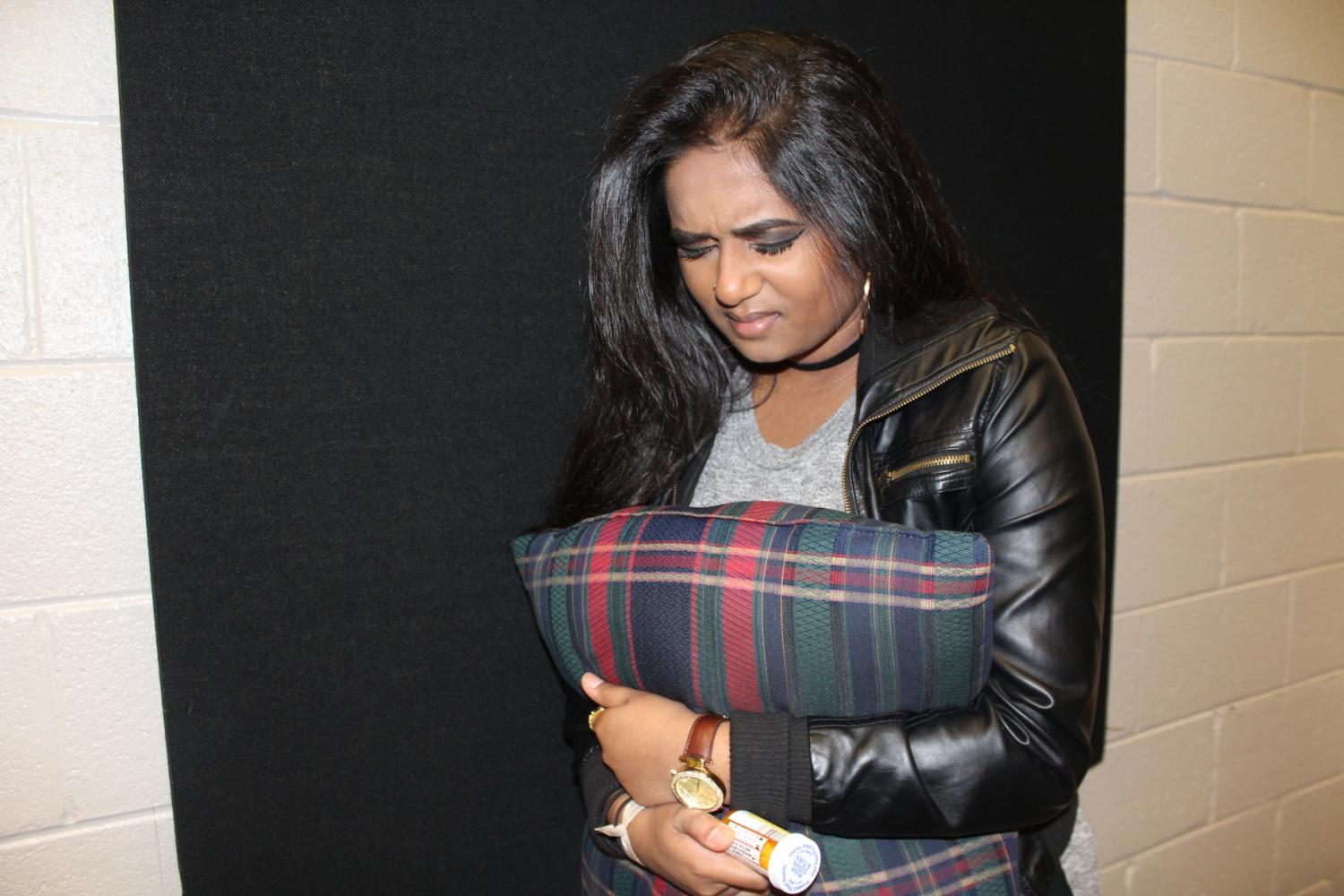There’s no “end” to Endometriosis
May 12, 2017
Endometriosis, a disorder that causes tissue growth outside of the uterus, commonly involves the ovaries, fallopian tubes, and the tissue that lines the pelvis. Intriguingly, the cause of this illness still remains unknown.
This unknown illness is one I know all too well.
One night I suffered from stabbing pains and felt like I was being electrocuted in my lower right abdomen. I decided to go to Kennestone Hospital, and after months of not knowing why my abdomen always felt so pressurized, the doctor finally diagnosed me with the common disorder.
During the ultrasound, my right leg partook in a momentary reflex and shot up, causing the doctor to realize the abnormality of the situation. He saw multiple chocolate cysts during the ultrasound and realized the unusual tissue growth outside of my uterus.
Endometriosis, with more than 200,000 U.S. cases per year, affects women around the country. Reports of the disorder often circle hospitals and urgent cares in Cobb County. One of the most recent cases, Chelsea Kelley, from Duluth, describes the cramping pain in her abdomen and talks about how she contacted her doctor after months of suffering the excruciating pains.

In a survey of 152 NC students, only 34 knew about the disease.
While the impact of this disorder includes needle-like pains in the ovarian region, the severity of the disorder depends on the region of the lesions. The pain worsens especially during menstruation, causing endometrioma to persist with long-term effects.
Unsurprisingly, hormone therapy offers an effective reduction to eliminate pains associated with endometriosis. Doctors often prescribe their patients with birth control pills as a starting treatment method. If the patient starts her treatment on birth control, she must attend a check-up every three months to ensure that the hormones stay balanced.
Kelley often turns to natural home remedies like heating pads, whiskey, and epsom salt baths to ease the pain. The disorder impacts her social life and ability to perform daily tasks as well.
“I went through pelvic exams and ultrasounds, then a diagnostic laparoscopy to be officially diagnosed. I have to continually explain to others that I’m not just having a bad period or being lazy, but that I have an actual disease that prevents me from doing all the things I would like to do,” Kelley said.
Endometriosis usually begins in the teen years and may last a lifetime. Different types of treatments help with the variety of symptoms the disorder offers, including medication and sometimes surgery.
Females who suffer from this disorder often struggle with infertility due to the inflammatory substances found in the cells affecting the body’s ability to familiarize with ovulation, fertilization, and implantation. In addition, those who suffer from this disorder have higher risks of certain types of ovarian cancers.
Every endometriosis patient goes through four stages. The first stage, commonly known as minimal endometriosis, which simply means the “starting” stage. This happens when tissue scarring seems present in the lining of the uterus. Gynecologists usually diagnose the chocolate cysts in the very first stage.
According to Clear Passage, mild endometriosis begins with stage two. Pelvic pain persists in a more aggressive manner in this stage and females experience more irritation during ovulation. Physically, black spots appear visible on the fibrous adhesions. Lesions commonly appear in this stage and locate between the uterus and rectum.
Stage three, referred to as the moderate stage, generally serves as the stage where the chocolate cysts occur. Chocolate cysts, or multiple cysts that pack tightly amongst each other, can be diagnosed with x-rays or regular ovarian ultrasounds. These cysts can eventually rupture and cause complications such as internal bleeding. In severe cases, they may be removed during a laparoscopy.
The final stage of endometriosis, commonly entitled as the “severe” stage, associates itself with numerous cysts and growing endometrioma. Stage four includes many digestive complications such as painful bowel movements, constipation, and severe abdominal pain that will not cease regardless of any type of painkiller. In addition, doctors may diagnose infertility in stage four.
Brooke Brown, from Marietta, continues to suffer from this disorder and realizes how the symptoms worsen when not addressed.
“I had surgery for Endometriosis and the surgery is life changing. I was bedridden after my first attack from it for three months. Trying to recover was the most difficult part,” Brown said.
Brown’s surgeon also removed a lot of the endo, a polyp from the bleeding it caused, and discussed how they also cut one of her organs because the endo formed around it, twisting it to where the function completely terminated. In the process of surgery, Brown’s chance for infertility caused by the scar tissue and the build up of endo on the ovaries and the fallopian tubes declined.
“It is definitely a risky surgery,” Brown said. “They really don’t know what they are going to need to do until they cut you open. You have to consent to everything possible and trust you have a good surgeon.”
Brown diets on a regular basis, staying away from gluten, sugar, red meat, dairy, and processed foods. She recommends staying away from inflammatory foods like these. In addition, she encourages yoga, having a steady sleep schedule, and pelvic massages to help loosen up the lesions.
Dr. Regina Robbins, M.D. for pediatric care, discusses the importance of visiting a gynecologist every few months.
“I have some young women like you who have been to the hospital mistaking these symptoms as appendicitis. Endometriosis is certainly not a disorder that should be ignored,” Robbins said. “Visiting your regular pediatrician is not enough. Gynecologists study beyond my scope, and beyond any pediatrician’s scope of practice.”
While regular pediatric care may be beneficial in certain aspects, it will only take care of the regular check-up routines and refill any medication such as Ortho-Cyclen, a common birth control pill. However, they will not take action in discussing different treatment methods or surgical procedures.
“It may be nerve-racking to visit a gynecologist especially at a young age. But everyone has a different stage of endometriosis. For some, it affects daily activities, for others, they don’t even know it is there,” Dr. Robbins said.
Medical doctors encourage teenagers to visit their local gynecologist before matters worsen and the disorder persists with long-term effects.

Grace Babcock • May 13, 2017 at 10:26 AM
Leda, this article is amazing! It is very mind-opening and inspiring. Endometriosis sounds terrible, and I’ m sorry you have to go through this. More people will understand the disease better because of this and sharing your story with the world will make a difference in young teens’ lives. Before reading this article I was one of the many who had no idea what endometriosis was, and im glad I know about the risk I could have at getting it. Really nice work, one of the many articles by you that I love!
Leda Catak • May 15, 2017 at 3:12 PM
Thank you for your sweet comment, Grace! I am so glad that you have a better understanding of what Endometriosis is. Yes, it is terrible to have a disorder like this but at the same time, I could teach people who don’t know a lesson. I appreciate your kind words, it means a lot!